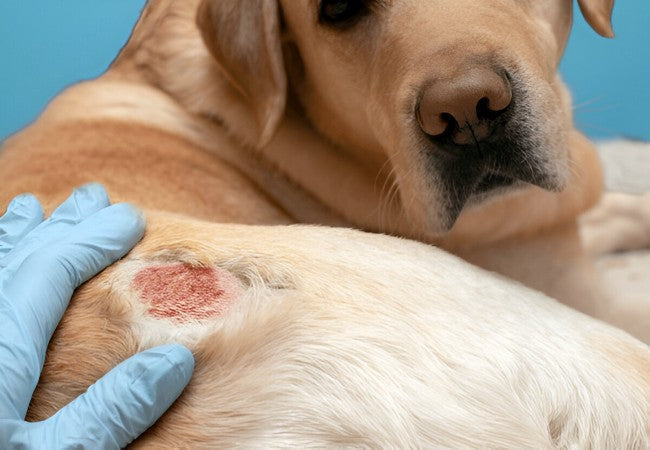Veterinary Guide to Canine Phlebitis (Thrombophlebitis) 2025 🩺🐶

In this article
Veterinary Guide to Canine Phlebitis (Thrombophlebitis) 2025 🩺🐶
By Dr. Duncan Houston BVSc
🧬 What Is Phlebitis?
Phlebitis refers to inflammation of a vein, most commonly affecting superficial veins near the skin. When accompanied by a clot, it is called thrombophlebitis.
👥 Causes & Risk Factors
- IV catheter placement: The most common cause in hospitalized dogs—mechanical irritation or bacterial entry leads to inflammation.
- Trauma: Injuries or bites overlying veins can also initiate phlebitis.
- Underlying clotting issues: Conditions like Cushing’s disease, kidney protein loss, cancer, or sepsis increase clot risk.
- Immune status & age: Puppies, seniors, obese, or immunocompromised dogs are more susceptible.
👀 Clinical Signs
- Warmth, redness, and tenderness along a vein—often appearing cord-like or swollen.
- Palpable firm vessel; local swelling and discomfort.
- Pus or discharge if infection is present; fever, lethargy—especially in deeper or septic cases.
🔍 Diagnosis
- History & exam: Look for IV catheter use, palpate vein for warmth and hardness.
- Doppler flow tests & ultrasound: Assess vein compressibility, wall thickness, and blood flow; thrombi appear as filling defects.
- Bloodwork & culture: CBC (leukocytosis), blood or catheter-tip culture for infection.
- Advanced imaging: X-ray, phlebography, or deeper ultrasound if deep vein involvement or embolism is suspected.
🚨 Treatment
1. Remove the Cause
- Discontinue and replace the IV catheter immediately if phlebitis is detected.
- Proper catheter-site care: change every 24 h in high-risk patients; use sterile technique and antimicrobial dressings.
2. Treat Infection & Inflammation
- Antibiotics: Empirical broad-spectrum while awaiting culture, then tailored treatment for 7–21 days.
- Local care: Warm, moist compresses, gentle massage to promote circulation.
- Anti-inflammatories: NSAIDs or corticosteroids if inflammation and pain are severe.
3. Prevent & Manage Clots
- Anticoagulants: Low-dose heparin, aspirin, or clopidogrel if thrombosis risk is high.
- Sterile fluid therapy: Ensuring catheter patency and preventing stagnant blood.
🩺 Prognosis & Monitoring
- Superficial phlebitis often resolves within days to weeks; deeper or septic cases carry a guarded prognosis.
- Ultrasound follow-up ensures thrombi have resolved; Doppler features improve with treatment.
- Monitor CBC, physical signs, limb use, and systemic symptoms regularly.
🏡 Prevention Strategies
- Rotate catheter sites every ≤36 hours—especially in dogs; dwell time correlates with phlebitis risk.
- Aseptic technique, regular dressings, and catheter securement to avoid movement.
- Early removal at first signs; avoid high-risk veins in future procedures.
- Manage risk factors: obesity, mobility, clotting disorders, endocrine disease.
📱 Ask A Vet Telehealth Support
- 📸 Upload photos of catheter sites to monitor redness or swelling remotely.
- 🔔 Receive reminders for catheter-site changes and rechecks.
- 🩺 Schedule ultrasound Doppler follow-up through Ask A Vet clinics.
🎓 Case Spotlight: “Bella” the Labrador
Bella, a 7-year-old retriever hospitalized for pancreatitis, developed phlebitis at her cephalic catheter site 48 hours after placement. The vein was red, tender, and raised, but she remained afebrile. The catheter was removed and replaced in a different limb, and she received a 10-day course of amoxicillin–clavulanate and NSAIDs. An ultrasound on day 7 showed reduced wall thickening and improved vein patency. Bella recovered fully and resumed gentle exercise with no recurrence. Ask A Vet reminders ensured site monitoring and medication adherence. 🐕🩹
🔚 Key Takeaways
- Phlebitis is inflammation of a vein, usually due to IV catheters or trauma.
- Signs: warmth, swelling, tenderness, hardened veins, discharge, fever in septic cases.
- Diagnosis via exam, Doppler ultrasound, bloodwork and cultures.
- Treat by removing IV lines, antibiotics, anti-inflammatories, and clot prevention.
- Prevention by aseptic care and rotating catheter sites every ≤36 h.
- Ask A Vet telehealth provides proactive site monitoring, reminders, and medication support 📲🐾
Dr Duncan Houston BVSc, founder of Ask A Vet. Download the Ask A Vet app today to monitor catheter sites, track inflammation, arrange diagnostics, and ensure fast recovery from phlebitis 🐶📲






